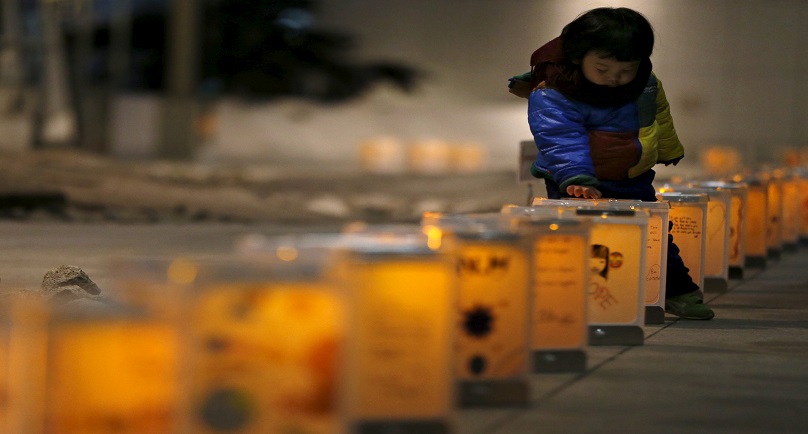Image: Lanterns from northern Japanese city Natori are illuminated during an event to pray for the reconstruction of areas devastated by the March 11, 2011 earthquake and tsunami, and mourn victims of the disaster at the Canadian embassy in Tokyo, Japan, March 10, 2016, a day before the five-year anniversary of the disaster. REUTERS/Issei Kato
![]()
By Elaine Lies and Hyun Oh
RIKUZENTAKATA, Japan (Reuters) – Japan on Friday mourns the thousands who lost their lives in a massive earthquake and tsunami five years ago that turned towns to matchwood and triggered the world’s worst nuclear disaster since Chernobyl in 1986.
The nine-magnitude quake struck offshore on a chilly Friday, sparking huge black waves along a vast swathe of coastline and killing nearly 20,000 people.
The tsunami crippled the Fukushima Dai-ichi Nuclear Plant, where meltdowns in three reactors spewed radiation over a wide area of the countryside, contaminating water, food and air.
More than 160,000 people were evacuated from nearby towns. Around 10 percent still live in temporary housing across Fukushima prefecture. Most have settled outside their hometowns and have begun new lives.
Some areas remain no-go zones due to the high radiation.
In coastal Rikuzentakata, which was flattened by a wave as much as 17 meters (56 ft) high and lost seven percent of its population along with its entire downtown, the pain remains strong.
“Infrastructure is recovering, hearts are not. I thought time would take care of things,” said Eiki Kumagai, a volunteer fireman who lost 51 colleagues, many killed as they guided others to safety.
“I keep seeing the faces of those who died… There’s so much regret, I can’t express it.”
Prime Minister Shinzo Abe and Emperor Akihito will offer flowers at a ceremony in Tokyo that will include a moment of silence at the time of the quake, 2.46 p.m. (0546 GMT), when bells will ring in the city center and residents across the nation bow their heads.
Japan, one of the world’s most seismically active areas, will mark the day with prayers, anti-nuclear protests and graveside visits. All the trains on the vast Tokyo underground network will halt to mark the moment the quake struck.
Billions of dollars in government spending have helped stricken communities rise from the ruins, including elevating the earth to protect them from future waves and cleaning radiation-contaminated land, but much remains to be done for thousands still languishing in barracks-like temporary housing.
“I get the feeling that the number of people who don’t know what to do, who aren’t even trying, is increasing,” said Kazuo Sato, a former fisherman from Rikuzentakata. “Their hearts are in pieces.”
Government spending on reconstruction is set to dip from the start of the new fiscal year in April. But Abe pledged continued support.
“There are still many people living difficult lives in temporary housing and those who because of the nuclear accident cannot return to the places they lived,” Abe told reporters on Thursday.
“We will speed up our efforts to build housing and disaster-proof towns … so they can return as quickly as possible to permanent housing and stable lives.”
(Reporting by Elaine Lies; Editing by Linda Sieg and Nick Macfie)
Copyright 2015 Thomson Reuters. Click for Restrictions.
Hearts-in-pieces-five-years-after-Tsunami-hits-Japan-media.jpg


